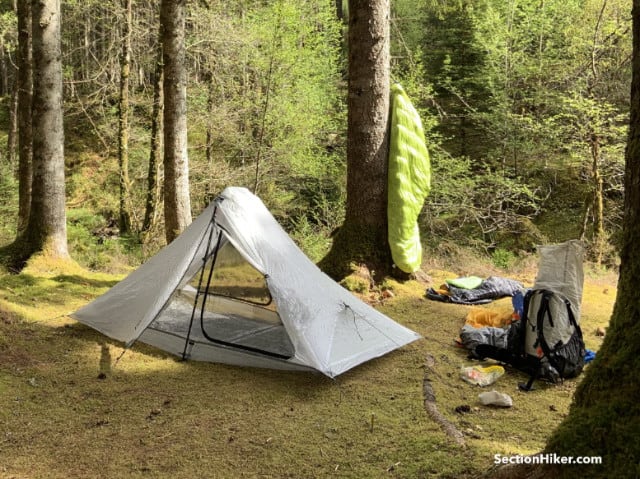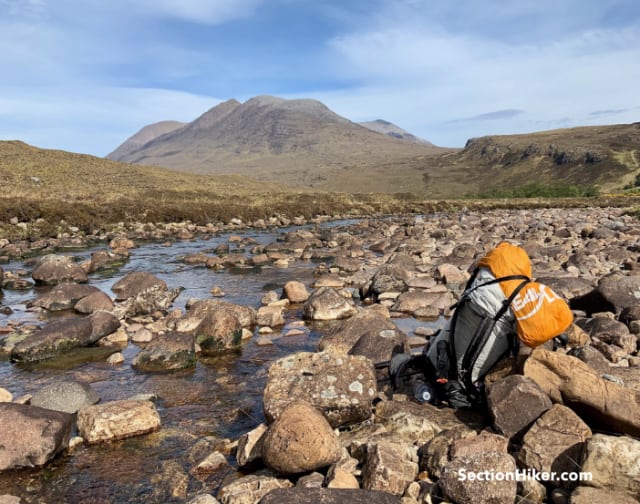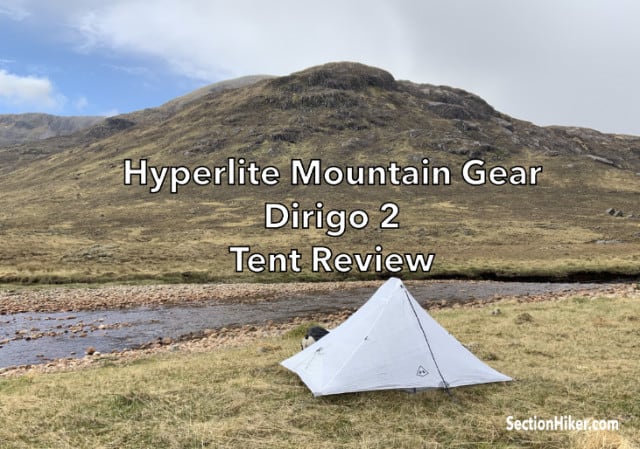The Hyperlite Mountain Gear Dirigo 2 is a hybrid single-wall/double-wall 2 person tent made with several different grades of Dyneema Composite Fabrics (DCF) that are strategically placed at different points in the tent’s architecture to balance the competing needs of strength, weight, and ventilation. Weighing 28 oz, the Dirigo 2 has a wind-resistant pyramid shape with two doors, two vestibules, and requires two trekking poles to erect. While Hyperlite has been making modular pyramid and tarp shelters for many years, this is the company’s first all-inclusive, one-piece tent with a sewn-in floor. (See the Dyneema Composite Fabrics FAQ for more information about this remarkable material.)
Hyperlite Mountain Gear Dirigo 2 Tent
Comfort
Ease of Setup
Weather Resistance
Durabilty
Weight
Packed Size
Specs at a Glance
- Weight: 28 oz, not including stakes
- Color: White
- Type: Single-wall/Double-wall hybrid
- Materials: DCF, DCF-WB, DCHW, Carbon Fiber, No-Seeum Mesh
- Doors: 2
- Vestibules: 2
- Minimum number of stakes to set up: 8
- Dimensions:
- Packed Size: 12” x 8” x 6” | 30.4cm x 20.3cm x 15.2cm | (9.5L)
- Interior Peak Height: 45″ | 114.5cm
- Floor Area: 52″ (W) x 90″ (L) | 32.5 sq. ft.
- Pitched Dimensions: 92″ (W) x 95″ (L)
- Pole Length: 49″ | 125cm
- Vestibule Area: 6.25 sq. ft. per vestibule (12.5 sq. ft. total)
- For full specs visit HyperliteMountainGear.com
Design
The Dirigo 2 is a two-person tent with a hybrid single wall / double wall design, with two side vestibules and two doors, and requires two trekking poles to set up. The sidewalls of the tent (behind the vestibules) are no-see-um mesh, with a D-shaped door on each side so occupants can have their own entrance. The vestibules are large enough that you can store a backpack in one and still get in and out of the tent, but they’re not really deep enough to cook under, even with a canister stove system. The vestibule doors do not reach all the way to the ground but have an air gap underneath to promote airflow through the tent to combat internal condensation. This is a common ventilation tactic in single wall tents but leads to a draftier tent in cooler weather.

The trekking poles holding up the tent are angled rather than vertical. They’re held in place at the handle end by a reinforced peak and at the tip by a grommet attached to the outside of the tent floor. The reinforced peaks are located at the ends of a short carbon fiber strut, which creates a short roof ridgeline rather than coming to a point like a true pyramid structure, in order to provide more interior room to sit up. This combination of structural elements creates a strong and quite rigid skeleton when the vestibules are zipped closed and pegged securely to the ground. The trekking pole architecture also lets you lower one pole and not the other if you can only pitch up on an uneven tent site or if you want to reduce the amount of airflow under the vestibule doors.

However, unzipping the vestibule doors and rolling back one half or the whole, weakens the structure considerably. This could easily be remedied by running guylines from the top of the roof peaks to the ground, so the Dirigo doors can be opened without reducing the strength of the tent. There are no tie-outs on the Dirigo’s peaks to run additional guylines, but this would be a useful and fairly easy mod to make with some minor sewing and seam sealer.

Ventilation and Internal Condensation
The Dirigo 2 is constructed with multiple grades of DCF including the use of waterproof breathable DCF-WB at the head and foot ends of the tent. The DCF-WB works wonderfully (I’m impressed), even when the remainder of the interior walls are drenched in condensation. However, the triangular patch of DCF-WB still results in condensation transfer to your footbox or head since it doesn’t span the width of the wall. Which begs the question: why use a small triangle of DCF-WB when you could make the lower half of the side wall with it, or even the entire wall and eliminate condensation altogether?

Internal condensation is a big issue with the Dirigo 2 when it’s used in a non-arid climate. While all single wall tents are prone to internal condensation, tent designers have come up with clever ways to combat it. One tried and true method is to sew an area of mesh between the floor and the tent wall, to facilitate airflow even when the vestibule doors are shut tight to block out rain or high wind. Another is to add peak vents in the ceiling of the tent to help vent the body heat and breath exhalations that exacerbate internal condensation. The Dirgo doesn’t have either. My solution is to carry a camp towel with me when I use the Dirigo 2, to sop up the internal condensation each morning.
Livability
While the Dirigo 2 is designed for use by one or two people, it’s far more comfortable as a spacious one person tent rather than a cramped two-person tent. The orientation of the doors, which are on opposite ends of their vestibules, assumes that your head will be positioned next to your partner’s feet and vice versa. Rainbow zippers would have been a better choice, so you have the option to orient your heads together.

The headroom inside the tent is good and there’s a mesh pocket that hangs below the ceiling strut which is super convenient for holding a phone or overhead lamp. There are also gear loops sewn into the seams which are convenient for hanging up glasses and other items so they’re not crushed underneath you.
The Dirigo 2 is only available in white-colored DCF. While it’s sufficiently opaque to provide a decent amount of internal privacy, the tent becomes insufferably hot if pitched in direct sunlight, even with the vestibules wide open. This is a common problem with many DCF shelters, including pyramid tarps.
Dirigo Setup and Packability
The Dirigo 2 is easy to set up because it has a rectangular floor plan. You simply stake out the corners at 45-degree angles, insert your trekking pole handles into the reinforced peaks, stake out the vestibules, stake out the side panels, and tension the linelocs and guylines. You can even pitch it in the pouring rain and keep the inside dry. There’s also no need for a footprint since the bathtub floor is made with a tougher grade of waterproof DCF.
To pack it up, reverse the process, but fold the tent up rather than stuffing it in order to minimize its packed volume. At 9.5L in size, packed, the Dirigo 2 is a bulky tent to carry. While it comes with a DCF stuff sack, it can be a struggle to get it to fit into it in the morning. If you’re careful and do get it into its stuff sack, it will barely fit horizontally into a Hyperlite Mountain Gear 3400 Southwest Backpack. But more often than not, especially when the interior is soaked with internal condensation, I carry it in a stuff sack lashed to the top of my backpack. This makes it much easier to set up and dry off in the sun during rest stops and helps prevent moisture from compromising the dry gear inside my backpack.

Comparable DCF Tents
Key: SW=Single Wall, DW=Double Wall
| Make / Model | SW/DW | People | Vestibules | Weight |
|---|---|---|---|---|
| Hyperlite Mountain Gear Unbound 2 | SW | 1-2 | 2 | 24 oz |
| Durston X-Mid Pro 2 | SW | 2 | 2 | 19.6 oz |
| Big Agnes Tiger Wall 2 Carbon | DW | 2 | 2 | 22 oz |
| MLD Duomid + Nest (all DCF) | DW | 2 | 1 | 26 oz |
| MLD Trailstar + Nest (all DCF) | DW | 1 | 1 | 20.5 oz |
| Tarptent Stratospire Li | DW | 2 | 2 | 27.7 oz |
| Zpacks Duplex | SW | 2 | 2 | 19.0 oz |
| Zpacks Duplex Zip | SW | 2 | 2 | 20.4 oz |
| Tarptent Aeon Li | SW | 1 | 1 | 15.8 oz |
| Tarptent Notch Li | DW | 1 | 2 | 21.5 oz |
There are relatively few one-person and two-person DCF tents available, and while tent weight and cost are important dimensions, it’s worth understanding what other variables are important to you before you make a purchase decision.
Here are some important dimensions that are worth considering when choosing between different tents and shelters. This might seem long a long set of variables, but they can help you avoid buying the wrong shelter, especially a shelter from a cottage manufacturer that you can’t return for a refund if it doesn’t meet your needs.
Footprint: How much space is required to set up the tent? For example, if you like to camp at unprepared (wild) test sites, it can be easier to find a level, dry, or open space for a one person tent instead of a two-person tent.
Draftiness: Some tents are draftier than others. For examples, shelters with a rain fly and vestibules that go all the way down to the ground tend to be warmer than those that don’t because they have less airflow. Tarp tents, where the fly and the floor are connected with mesh, tend to draftier than double wall tents.
Pitching in the Rain: Can you set up a tent in the rain and keep the inner tent dry? You can with most single wall tents and some double wall tents, but not with ones that require that you pitch the inner tent first.
Ease of Pitch: Some shelters are easier to set up than others. The simplest ones are tents that have an exoskeleton frame, which is one reason why they are so widely used on mainstream tents. When it comes to cottage manufactured tents, ones that have a rectangular footprint and symmetric sides are usually easier to set up than ones that have offset, asymmetric peaks or asymmetric walls.
Modularity: Do you want the ability to split apart your shelter into components and only use part of it in different weather or terrain? For example, buying a pyramid tarp and an inner nest, or a double wall tent, can be much more flexible than buying a single wall tent with a permanently sewn-in floor.
Internal condensation: Many people prefer a double-wall tent because they can’t stand the thought of internal condensation making their gear damp.
Interior Space: Do you want to be able to store your gear inside the tent with you? If so, you might be better off buying a two-person tent and using it by yourself. Do you need a tent that can fit two people, even though realistically you plan to mostly use it for one person?
Dimensions: Do you prefer a tent with a high ceiling or one that’s long because you are a tall person. Do you prefer a tent with vertical or high-angled end walls because you have big feet that will touch a sloped ceiling?
Number of Doors: If you plan on using a two-person tent for two people, it is much more convenient to have one with two doors.
Ease of Entry: Tents that have wide side doors are usually easier to get in and out of than ones that have a narrow front door. In addition, wide vestibules with two independent doors (split in the middle), make it possible to use one half for gear storage and the other half for entry.

Assessment
Hyperlite Mountain Gear has been selling modular pyramid and tarp-based shelters for many years, but the Dirigo 2 is their first self-contained tent. While the Dirigo 2 is a strong shelter, given its pyramid shape and DCF construction, and suitable for use in high wind, it is quite prone to internal condensation when used in non-arid environments. While all single wall shelters are susceptible to internal condensation (see also How to Prevent Tent Condensation), I’ve indicated a number of tweaks above that could be made to the Dirigo design to significantly reduce the issue and make it more optimal to use in a wider range of conditions. While the Dirigo is well made and bomber tough like Hyperlite’s other DCF backpacking gear, my advice would be to hold out until the Dirigo 2.0 version ships and the shelter is refined still further.
Disclosure: Hyperlite Mountain Gear provided the author with a tent for this review.
SectionHiker is reader-supported. We only make money if you purchase a product through our affiliate links. Help us continue to test and write unsponsored and independent gear reviews, beginner FAQs, and free hiking guides. SectionHiker.com Backpacking Gear Reviews and FAQs
SectionHiker.com Backpacking Gear Reviews and FAQs 
Excellent points Philip. I rely on your hands on reviews when it comes to buying gear. Keep up the awesome work!
I was wondering how the Dirigio fared on your super-cool Cape Wrath trip. I guess not as well as hoped. $800 for a tent that needs improvements? HMG should have sent you a prototype for field testing before taking this to market. Seems like typical manufacturer’s error to me. Lots of impressive-seeming engineering and design, such as carbon fiber strut linking the two trekking poles and use of different kinds of dyneema, but insufficient real-world testing. I guess Scotland’s weather gets pretty real-world.
Have you heard when they plan to start shipping the Dirigo version 2.0?
I was under the impression that it’s available now.
First of all,thank you for this website.I look forward to it each week.Ever since the Dirigo came out,I’ve compared
it to my Duplex.Did the sloping doors prevent good cross ventilation during light rain? It seems like rain would come into the tent with the vestible doors rolled up. Thanks alot!
The Dirigo ventilation is terrible with the doors closed. Rain can come in the vestibules when they’re rolled up. The Duplex is a much better tent for US backpacking trails. There’s just no comparison.
Here is the reply I received from HMG regarding the Dirigo version 2.0:
“Thanks for reaching out to us. At this time we have no set date to release a 2.0 version of our Dirigo 2. We have put years of effort and testing into our Dirigo 2 and we have it how we like it!
If you have any further questions, please don’t hesitate to ask.
Thank you for your support in Hyperlite Mountain Gear!
Dylan”
I was hoping for a different response. Thanks for all you do for the backpacking community.
I’m sorry if I confused you by calling it the Dirigo 2.0. That was a tongue-in-cheek way of saying that you should avoid the current (just shipped) version and wait for them to fix the tent in the future. Given the number of negative reviews of the Dirigo, I’m really surprised that they’re not considering some modifications. It would be easy to make it a much better tent.
I own Dirigo 2 till now and I’m loving it. My only curiosity is how this tent will perform especially from the YKK aquaguard during the rain whether the water and heavy rain will enter from the zipper and let the bathfloor wet or not. If that’s the case and ever happened, this might change the way I see about this tent. Aside of it, this tent is awesome!
HMG has stopped manufacturing it.
Will they make modifications and reintroduce it
No. I think it’s dead.